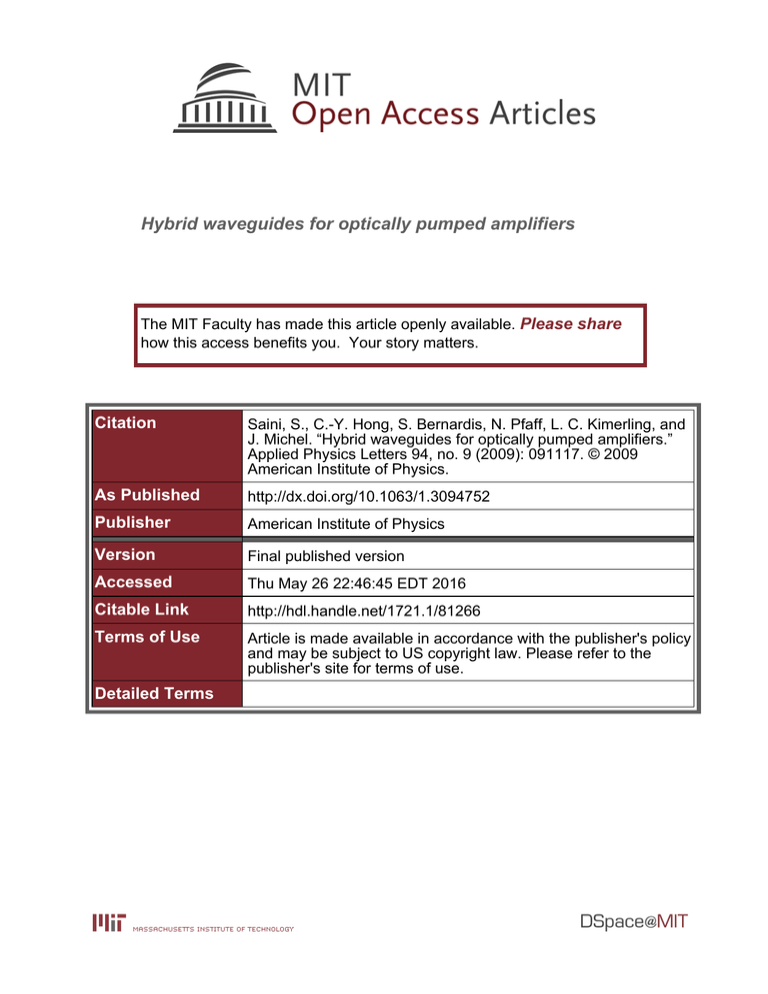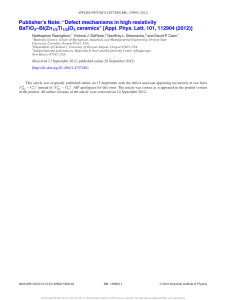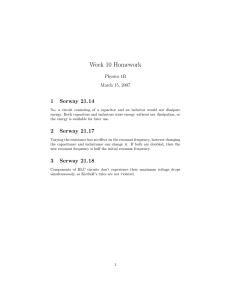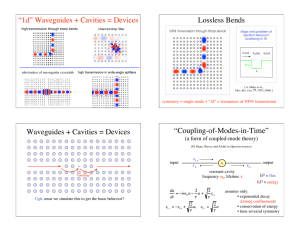Hybrid waveguides for optically pumped amplifiers Please share
advertisement

Hybrid waveguides for optically pumped amplifiers The MIT Faculty has made this article openly available. Please share how this access benefits you. Your story matters. Citation Saini, S., C.-Y. Hong, S. Bernardis, N. Pfaff, L. C. Kimerling, and J. Michel. “Hybrid waveguides for optically pumped amplifiers.” Applied Physics Letters 94, no. 9 (2009): 091117. © 2009 American Institute of Physics. As Published http://dx.doi.org/10.1063/1.3094752 Publisher American Institute of Physics Version Final published version Accessed Thu May 26 22:46:45 EDT 2016 Citable Link http://hdl.handle.net/1721.1/81266 Terms of Use Article is made available in accordance with the publisher's policy and may be subject to US copyright law. Please refer to the publisher's site for terms of use. Detailed Terms Hybrid waveguides for optically pumped amplifiers S. Saini, C.-Y. Hong, S. Bernardis, N. Pfaff, L. C. Kimerling et al. Citation: Appl. Phys. Lett. 94, 091117 (2009); doi: 10.1063/1.3094752 View online: http://dx.doi.org/10.1063/1.3094752 View Table of Contents: http://apl.aip.org/resource/1/APPLAB/v94/i9 Published by the AIP Publishing LLC. Additional information on Appl. Phys. Lett. Journal Homepage: http://apl.aip.org/ Journal Information: http://apl.aip.org/about/about_the_journal Top downloads: http://apl.aip.org/features/most_downloaded Information for Authors: http://apl.aip.org/authors Downloaded 24 Jul 2013 to 18.51.3.76. This article is copyrighted as indicated in the abstract. Reuse of AIP content is subject to the terms at: http://apl.aip.org/about/rights_and_permissions APPLIED PHYSICS LETTERS 94, 091117 共2009兲 Hybrid waveguides for optically pumped amplifiers S. Saini,a兲 C.-Y. Hong, S. Bernardis, N. Pfaff, L. C. Kimerling, and J. Michel Department of Materials Science and Engineering, Massachusetts Institute of Technology, Cambridge, Massachusetts 02139, USA 共Received 19 August 2008; accepted 11 February 2009; published online 6 March 2009兲 A hybrid waveguide based on simultaneous propagation of photonic crystal 共PC兲 and total internal reflection confined optical modes is introduced for a scheme to uniformly pump waveguide optical amplifiers 共WOAs兲. Planar one-dimensional PC structures were deposited by plasma enhanced chemical vapor deposition and characterized by reflectivity as a function of angle, confirming the existence of PC defect states. Two design trade-offs, angular acceptance and critical coupling, are modeled to demonstrate optimization of optically pumped gain within the PC defect state. The advantage of uniform pumping on the WOA gain profile is briefly discussed. © 2009 American Institute of Physics. 关DOI: 10.1063/1.3094752兴 c/sinθ n2 nd ω2 ω1 -β1 β2β1β2 β n1 Si 20 λ (m) 4 0.95 0.85 10 0 0 Si 1.05 0 30 θ (°) 30 60 θ (°) 60 90 (b) (a) γmax 2 0 30 Confinement × 1 γ (m-1) 90 Enhancement ω ω TEST PROPOSED STRUCTURE DEVICE r r E r k r (TE) θ B k β θ (°) DISPERSION RELATION loss—to achieve a scheme for out-of-plane amplification12 of optically pumped waveguide optical amplifiers 共WOAs兲.13 This scheme employs the hybrid PC waveguide design,14–17 simultaneously confining and guiding light by total internal reflection 共TIR兲 and the photonic band gap effect. Two test structures for evaluating the proposed device were grown by plasma enhanced chemical vapor deposition 共PECVD兲 on oxidized silicon 共Si兲 in a Si complementary metal-oxide semiconductor-compliant cleanroom. Reflectivity measurements were done using a Carey 5E UV-vis-near infrared dual-beam spectrophotometer. Film thickness and refractive index of the individual layers were calibrated by a KLA-Tencor-Prometrix UV-1280 ellipsometer 共 = 633 nm兲. Theoretical reflectivity plots were calculated by means of the transfer matrix method. Test structures 1 and 2 comprise defect layers clad by a symmetric number of periodic thin films; both structures are λ (nm) Photonic crystal 共PC兲 waveguides guide light within a “defect” region, a volume of material that disrupts the periodic refractive index profile of a composite medium in one, two, or three dimensions.1–3 Defect regions are designed by the choice of refractive index and dimensions in order to confine wavelengths of light otherwise inhibited by the optical band gap4 of the periodic medium. For one-dimensional 共1D兲 PCs, light propagation occurs along the two dimensions of translational invariance, dubbed the defect layer.5 In experimental PC waveguides,6–11 the finite amount of periodic media surrounding a defect region results in a complex propagation wavevector and thus loss in guided optical power per unit length.6,10 The preponderance of PC waveguide applications largely focus on the reduction in this loss propagation. In this letter we design and characterize 1D PC waveguides that employ the properties of finite confinement—the existence of a non-negligible propagation 20 0.5 Net × 10 0 0 30 (c) θ (°) 60 0 90 FIG. 1. 共Color online兲 共a兲 Schematic diagrams. Dispersion relation depicts the uncertainty in the band structure of defect states for a finite PC with resonant transmission linewidth ⌬. Test structure depicts orientation of light 共wavevector k៝ 兲, , and  with respect to deposited samples 共Si substrate兲. Proposed device depicts orientation of ៝ electric field, B៝ TE mode light 共E magnetic field兲 with respect to asymmetric-clad device. 共b兲 Angular acceptance ⌬ and cold cavity linewidth ⌬ vs . Inset: resonant transmission wavelength vs . 共c兲 Reflectivity R vs for symmetric test structure 2 共top兲 and asymmetric proposed device 共bottom兲. 共d兲 Gain ␥ and enhancement factors 共Confinement ⫻, Net ⫻兲 vs for proposed device. ␥max is the upper limit due to complete population inversion of Er. (d) a兲 Electronic mail: sajan.saini@qc.cuny.edu. Present address: Department of Physics, Queens College of CUNY, Flushing, NY 11367, USA. 0003-6951/2009/94共9兲/091117/3/$25.00 94, 091117-1 © 2009 American Institute of Physics Downloaded 24 Jul 2013 to 18.51.3.76. This article is copyrighted as indicated in the abstract. Reuse of AIP content is subject to the terms at: http://apl.aip.org/about/rights_and_permissions 091117-2 Saini et al. Appl. Phys. Lett. 94, 091117 共2009兲 FIG. 2. 共Color online兲 Test structure 1. 共a兲 TE polarization photonic band diagram for the SiO2 / SiNx 1D PC containing a SiO2 defect layer. 共b兲 Refractive index and power profile of confined modes at = 900 nm 共blue dashed lines兲 and = 542 nm 共red solid lines兲. 共c兲 TE reflectivity theory 共blue dashed lines兲 and experimental data 共red solid lines兲 at = 37°. FIG. 3. 共Color online兲 Test structure 2. 共a兲 TE polarization photonic band diagram for the SiO2 / SiNx 1D PC containing a SiNx defect layer. 共b兲 Refractive index and power profile of confined modes at = 1537 nm 共blue dashed lines兲 and = 980 nm 共red solid lines兲. 共c兲 TE reflectivity theory 共blue dashed lines兲 and experimental data 共red solid lines兲 at = 32.5°. deposited on a Si substrate 关see “Test Structure” schematic in Fig. 1共a兲兴. Test structure 1 is a conventional PC waveguide with a silicon oxide defect layer 共SiO2; refractive index of nd = 1.45, film thickness of dd = 1015 nm兲, clad by periodic layers of SiO2 共n1 = 1.45, d1 = 515 nm兲 and Si-rich silicon nitride 共Si-rich Si3N4, i.e., SiNx; n2 = 2.2, d2 = 325 nm兲 关see Fig. 2共b兲 for refractive index profile兴. Figure 2共a兲 shows the associated 1D photonic projection band diagram for transverse electric 共TE兲 polarization, where angular frequency of light and propagation constant  have been plotted in units renormalized to 2c / L and 2 / L, respectively 共c is the free space speed of light and L = d1 + d2 = 839 nm兲. A dispersion curve, lying within the photonic band gap 共unshaded region兲, represents guided modes of light. TE light of wavelength 共wavevector k = 2 / 兲, incident from above 共i.e., out-of-plane兲 at an angle with respect to the normal 关see Fig. 1共a兲兴, has  = k sin . In Fig. 2共a兲, wavelengths of light incident at angle are depicted by a line with slope 关 / 共2c / L兲兴 / 关 / 共2 / L兲兴 = 1 / sin 共renormalized units兲. TE reflectivity at = 37° was experimentally measured 关Fig. 2共c兲兴, demonstrating direct correspondence between 共A兲 reflectivity stopband and the photonic band gap and 共B兲 reflectivity resonant transmission and the dispersion curve. Figure 2共c兲 experimentally confirms resonant transmission close to = 542 and 900 nm, as predicted along the = 37° line in Fig. 2共a兲 共see comment two paragraphs below about fitting error兲. Figure 2共b兲 plots the modal solution for these wavelengths and confirms power confinement to within the defect layer. The scheme proposed for out-of-plane amplification of optically pumped WOAs relies on correspondence property 共B兲. Figure 3共b兲 shows the refractive index profile for test structure 2 共n1 = 1.45, d1 = 176 nm; n2 = 2.2, d2 = 116 nm兲. By selecting a SiNx defect layer 共nd = 2.2, dd = 464 nm兲 and cladding it with a thick spacer layer of SiO2 共dspacer = 540 nm兲, TIR modes can simultaneously be guided within the defect layer. If the defect layer is doped with erbium 共Er兲, these optically active centers can be pumped out-of-plane 关see “Proposed Device” schematic in Fig. 1共a兲兴 by resonant coupling of pump wavelength pump = 980 nm, while a TIR mode propagates in-plane and acquires optical gain 共at signal = 1537 nm兲 from the population-inverted Er. Figure 3共a兲 shows the photonic projection band diagram for test structure 2: at pump = 980 nm, a PC propagating mode exists above the free space light-line. At signal = 1537 nm, only a TIR propagating mode exists; this mode lies below the free space light-line and is confined within a pair of light-lines with slopes renormalized to waveguide core and cladding refractive indices. For this hybridized design, the SiNx defect layer corresponds to a waveguide core 共ncore = 2.2兲, and the SiO2 spacer layers correspond to waveguide cladding 共ncladding = 1.45兲. The SiO2 spacer layers are chosen to be ⬃3 ⫻ d1, adequately isolating the TIR mode evanescent tail from the PC cladding. Figure 3共b兲 plots the modal solution for pump and signal, confirming power confinement to within the defect layer. Figure 3共c兲 shows experimental TE reflectivity at = 32.5°, confirming resonant transmission at = 980 nm. For = 1537 nm, reflectivity data do not show any stopband or resonant transmission; since the TIR waveguide propagating state lies below the free space light-line, it cannot be accessed from an out-of-plane reflectivity experiment. Transmission electron microscopy images of like-deposited samples18 have shown a deviation in nominal layer thicknesses of 10–15 nm to account for the ⫾5 nm discrepancy in resonant wavelength between experiment and theory 关as seen in Figs. 2共c兲 and 3共c兲兴. We similarly attribute the presence of secondary reflectivity dips, in the experimental stopband and adjacent peaks, to these calibration deviations in PECVD deposition versus nominal design. We conclude with two comments concerning device optimization. 共1兲 The finite number of PC pairs implies a resonance transmission linewidth ⌬ or ⌬ such that / ⌬ = / ⌬ ⯝ Q, where Q is the cavity quality factor. A one-toone correspondence can be made between ⌬ and an angular acceptance ⌬ for coupling pump from out-of-plane at angle . The dispersion curve schematic in Fig. 1共a兲 shows a parabolic band for the PC propagating mode; at  = 0, the linewidth ⌬ ⬅ 2⌬ can be modeled by sketching two additional parabolas vertically displaced ⫾⌬ / 2. For resonant transmission at 2, the finite linewidth implies 2 ⬍  ⬍ 2⬘. The simplest approximation of assuming all three bands having identical curvature gives the relation 2⬘2 − 22 = ⌬ / 共d2 / d2兲. 2⬘2 − 22 has the same qualitative trend as ⌬; we infer that increasing either Q 共more periodic layers兲 Downloaded 24 Jul 2013 to 18.51.3.76. This article is copyrighted as indicated in the abstract. Reuse of AIP content is subject to the terms at: http://apl.aip.org/about/rights_and_permissions 091117-3 Appl. Phys. Lett. 94, 091117 共2009兲 Saini et al. or d2 / d2 共less dispersive PC propagating mode兲 will decrease ⌬. In Fig. 1共b兲 共left axis兲, we calculate ⌬共兲 for the proposed device 共five SiO2 / SiNx upper cladding pairs, three lower cladding pairs; Q ⯝ 230兲 using theoretical reflectivity spectra. For a given , the linewidth 共right axis兲 and resonant transmission wavelength 共inset兲 are referred to as nominal values. is then slightly increased 共decreased兲 until the nominal resonant wavelength no longer lies within the 3 − dB linewidth of the blueshifted 共redshifted兲 resonant transmission peak. ⌬ represents this range of . ⌬ decreases monotonically with , except for angles close to = 0°. Figure 1共a兲 dispersion schematic shows 共for close to 0°兲 resonant transmission at 1 corresponds to −1 ⬍  ⬍ 1.  ⬍ 0 simply means pump can be incident at ⬍ 0°, i.e., couple to a counterpropagating PC mode. The general trend in ⌬共兲 and ⌬共兲 shows that a laser pump of given linewidth will have efficient power insertion at smaller incident angles. 共2兲 Critical coupling19 matches the rate of power insertion through the upper cladding 共“upper” mirror loss ␣m1兲 into a resonant cavity to the sum of the rates of power dissipation within the cavity 共absorption兲 and power extraction through lower cladding 共“lower” mirror loss ␣m2兲. Critical coupling optimizes coherent buildup of cavity power and ensures 100% resonant transmission at pump.20 The proposed device mirror loss, calculated from normal incidence cold cavity linewidth ⌬ 共Ref. 19兲 in Fig. 1共b兲, is ␣m = ␣m1 + ␣m2 ⯝ 2nd⌬ / 2 ⯝ 0.06 m−1. In comparison, absorption by N = 2 ⫻ 1020 Er/ cm−3 at pump = 980 nm 共interaction cross-section13 pump ⯝ 10−21 cm2兲 is ␣abs ⯝ 共N1 − N3兲pump ⬇ Npump = 2 ⫻ 10−5 m−1 共N1 and N3 are the ground and second excited state populations, respectively13兲. ␣abs Ⰶ ␣m, implying a symmetric design such as test structure 2 共three SiO2 / SiNx pairs in upper/lower cladding兲 should be close to critical coupling. However, Fig. 1共c兲 共top兲 shows theoretical reflectivity at three angles; none of the resonant peaks have close to 100% transmission because the Si substrate introduces considerable asymmetry to the refractive index profile. The proposed device has an asymmetric cladding and is thus closer to critical coupling 关Fig. 1共c兲, bottom兴. Optical gain 关␥ ⯝ 共N2 − N1兲signal, N2 is the first excited state population13兴 for the proposed device is modeled in Fig. 1共d兲, using the Er parameters cited in Ref. 13, with an Er concentration of 2 ⫻ 1020 cm−3. Figure 1共d兲 共right axis兲 plots the pump power enhancement in the defect layer as “Con2 = 共1 / ext兲 / 共1 / ttransit兲关共1 / ttransit兲 / 共1 / 兲兴2. finement ⫻ ” = Tncirc −␣m1dd ⬇ ␣m1dd = vgttransit / vgext is the steadyT = 1 − R1 = 1 − e state fraction of power transmitted into the cavity through the upper cladding 共with R1 reflectivity, vg group velocity, ttransit time for pump to cross the cavity兲. ncirc = deff / dd = vg / vgttransit is the number of recirculation passes of superposing traveling electromagnetic waves, trapped for an effective path length deff within the cavity, until dissipation. is the proposed device cavity lifetime calculated from the resonant transmission linewidth using Q = ⬇ / ⌬. ext is the lifetime for insertion/extraction of power through the upper cladding; it is calculated from half the linewidth of resonant transmission through a structure with five SiO2 / SiNx pairs cladding defect and spacer layers, with no Si substrate. 共Confinement ⫻ can similarly be derived from the converging sum of transmitted electric field and higher order reflections, evaluated at the center of the cavity, for the resonant wave- length condition兲.20 Net ⫻ estimates the insertion loss of the externally coupled pump by weighting Confinement ⫻ with the ratios ⌬ / ⌬laser · ⌬ / ⌬laser 共⌬laser = 1° and ⌬laser = 5 nm are the presumed angular tolerance and linewidth of the laser pump, respectively兲. We apply the rule ⌬ / ⌬laser = 1 for ⌬ ⬎ ⌬laser and ⌬ / ⌬laser = 1 for ⌬ ⬎ ⌬laser, resulting in the flat-top feature at small angles for Net ⫻. Two trade-off comments are apparent: 共a兲 while a higher Q with critical coupling increases Confinement ⫻, a reduction in ⌬ and ⌬ implies an eventual decrease in Net ⫻ and 共b兲 for Q ⯝ 230, Confinement ⫻ increases with significantly, but the strong decrease in ⌬ and ⌬ implies that Net ⫻ does not favor coupling at large angles. ␥ is calculated 关Fig. 1共d兲, left axis兴 with Net ⫻ multiplying a pump power of 3 mW 共400 m diameter beam spot兲 and assuming a signal in the defect layer of incident power 1 W. For the proposed device, we observe that Q ⯝ 230 provides a large enough Confinement ⫻ to invert the 2 ⫻ 1020 cm−3 Er population and result in ␥ ⬎ 0. In conclusion, we have modeled, fabricated, and measured PC test structures that demonstrate the design of a hybrid waveguide for out-of-plane optically pumped WOAs. Previously,13 we analyzed the influence of index contrast on the gain efficiency of optically pumped WOAs: the need to co- or counter-propagate a pump wavelength results in a subexponential decay of pump power along the WOA and a nonuniform gain profile,20 making length a critical device parameter for optimizing gain. The hybrid structure presented here allows one to circumvent this constraint and achieve the more uniform gain profile characteristic of electrically injected semiconductor optical amplifiers. The authors would like to thank Professor K. Wada 共Department of Materials Engineering, The University of Tokyo兲 for theoretical discussions concerning PC waveguide design. E. Yablonovitch, J. Mod. Opt. 41, 173 共1994兲. J. D. Joannopoulos, P. R. Villeneuve, and S. Fan, Nature 共London兲 386, 143 共1997兲. 3 J. D. Joannopoulos, R. D. Meade, and J. N. Winn, Photonic Crystals: Molding the Flow of Light 共Princeton University Press, Princeton, 1995兲. 4 E. Yablonovitch, J. Opt. Soc. Am. B 10, 283 共1993兲. 5 E. Yablonovitch, T. J. Gmitter, R. D. Meade, A. M. Rappe, K. D. Brommer, and J. D. Joannopoulos, Phys. Rev. Lett. 67, 3380 共1991兲. 6 M. Ibanescu, Y. Fink, S. Fan, E. L. Thomas, and J. D. Joannopoulos, Science 289, 415 共2000兲. 7 P. Russell, Science 299, 358 共2003兲. 8 J. C. Knight, J. Opt. Soc. Am. B 24, 1661 共2007兲. 9 K. K. Lee, A. Farjadpour, Y. Avniel, J. D. Joannopoulos, and S. G. Johnson, Proc. SPIE 6901, 69010K 共2008兲. 10 Y. Yi, S. Akiyama, P. Bermel, X. Duan, and L. C. Kimerling, IEEE J. Sel. Top. Quantum Electron. 12, 1345 共2006兲. 11 Y. Fink, J. N. Winn, S. Fan, J. Michel, C. Chen, J. D. Joannopoulos, and E. L. Thomas, Science 282, 1679 共1998兲. 12 M. Lipson and L. C. Kimerling, U.S. Patent No. 6,567,209 共20 May 2003兲. 13 S. Saini, J. Michel, and L. C. Kimerling, J. Lightwave Technol. 21, 2368 共2003兲. 14 G. P. Nordin, S. Kim, J. Cai, and J. Jiang, Opt. Express 10, 1334 共2002兲. 15 S.A. Cerqueira, Jr., F. Luan, C. M. B. Cordeiro, A. K. George, and J. C. Knight, Opt. Express 14, 926 共2006兲. 16 L. Xiao, W. Jin, and M. S. Demokan, Opt. Express 15, 15637 共2007兲. 17 X. Sun, Opt. Lett. 32, 2484 共2007兲. 18 S. Saini, C.-Y. Hong, N. Pfaff, L. C. Kimerling, and J. Michel, Appl. Phys. Lett. 93, 261102 共2008兲. 19 H. A. Haus, Wave and Fields in Optoelectronics 共Prentice-Hall, Saddlebrook, NJ, 1983兲. 20 L. A. Coldren and S. W. Corzine, Diode Lasers and Photonic Integrated Circuits 共Wiley, New York, 1995兲. 1 2 Downloaded 24 Jul 2013 to 18.51.3.76. This article is copyrighted as indicated in the abstract. Reuse of AIP content is subject to the terms at: http://apl.aip.org/about/rights_and_permissions




